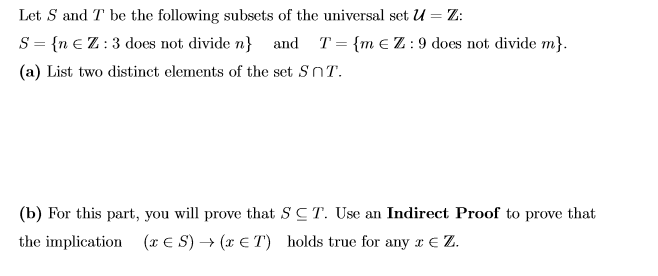Let S and T be the following subsets of the universal set U = Z: S = {n € Z :3 does not divide n} and T= {m € Z : 9 does not divide m}. %3D (a) List two distinct elements of the set SnT. (b) For this part, you will prove that SCT. Use an Indirect Proof to prove that the implication (x e S) → (x E T') holds true for any x € Z.
Let S and T be the following subsets of the universal set U = Z: S = {n € Z :3 does not divide n} and T= {m € Z : 9 does not divide m}. %3D (a) List two distinct elements of the set SnT. (b) For this part, you will prove that SCT. Use an Indirect Proof to prove that the implication (x e S) → (x E T') holds true for any x € Z.
Elements Of Modern Algebra
8th Edition
ISBN:9781285463230
Author:Gilbert, Linda, Jimmie
Publisher:Gilbert, Linda, Jimmie
Chapter1: Fundamentals
Section1.1: Sets
Problem 6E: 6. Determine whether each of the following is either , , , or , where is an arbitrary subset of the...
Related questions
Question
part B

Transcribed Image Text:Let S and T be the following subsets of the universal set U = Z:
S = {n € Z:3 does not divide n} and T= {m eZ:9 does not divide m}.
(a) List two distinct elements of the set SnT.
(b) For this part, you will prove that SCT. Use an Indirect Proof to prove that
(x € S) → (x € T) holds true for any r € Z.
the implication
Expert Solution
This question has been solved!
Explore an expertly crafted, step-by-step solution for a thorough understanding of key concepts.
Step by step
Solved in 2 steps with 1 images

Knowledge Booster
Learn more about
Need a deep-dive on the concept behind this application? Look no further. Learn more about this topic, advanced-math and related others by exploring similar questions and additional content below.Recommended textbooks for you

Elements Of Modern Algebra
Algebra
ISBN:
9781285463230
Author:
Gilbert, Linda, Jimmie
Publisher:
Cengage Learning,

Elements Of Modern Algebra
Algebra
ISBN:
9781285463230
Author:
Gilbert, Linda, Jimmie
Publisher:
Cengage Learning,